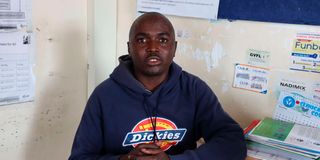The silent struggles of young men living with HIV

Kelvin Barasa, 24, a peer educator who was born with HIV, during the interview in Athi River, Machakos County.
What you need to know:
- According to the Kenya HIV Estimates for 2024, the proportion of young men aged 15-24 years who are on antiretroviral therapy (ART) is still lower than their female counterparts.
In the heart of Athi River, Machakos County, Kelvin Barasa has been leading a miserable life.
His story begins in a place of isolation. “I discovered I was HIV positive when I was 15,” he says. Sitting in the waiting room at Athi River Level 4 Hospital, where he collects his life-saving treatment, his voice carries a weight of lived experience, the kind that can only come from years of feeling alone in a world that doesn’t understand you.
“I faced rejection at home. There was a time I was so sick I couldn’t even go to school, and when I did, I was treated differently. I felt like a prisoner in my own body, and no one seemed to care,” shares the 24 year old who was born with HIV.
The fear of stigma and discrimination pushed Kelvin to a dark place when he stopped taking his medication in 2011. Nearly two years without treatment led to severe health deterioration. “I developed wounds all over my body,” he says.
“It was a wake-up call, and I knew I had to go back to my drugs.” In 2013, he resumed taking medication. But his health had already taken a major hit, and the long-term effects of skipping medication continue to haunt him to date. It has been a constant struggle to rebuild his health, and regain the energy, which was once stolen from him.
Kenya has one of the largest HIV epidemics in the world. In 2023, an estimated 1.4 million people were living with HIV in the country, with new infections disproportionately affecting young people.
Adolescents and young adults between the age of 15 and 34 contributed to 73 per cent of all new HIV infections in 2023, according to the HIV Estimates report. “This troubling statistic highlights the urgency of addressing the unique needs of this demographic, particularly young men, who face distinct challenges when it comes to accessing care and support,”explains Caroline Kinoti, deputy CEO at the National Syndemic Disease Control Council (NSDCC).
Despite efforts to reduce the burden of the virus, young men continue to be left behind in Kenya’s fight against HIV. According to the National HIV Estimates 2024, while the number of new infections has declined overall, young men aged 20-24 years are lagging behind in terms of treatment uptake.
Treatment interruption rates are higher among men than women, with 4.22 per cent of male adults experiencing treatment interruptions in 2023, compared to 3.8 per cent of women.
For Kelvin, these statistics are not just numbers—they are a reflection of his personal experience. As a young man living with HIV, he has had to contend with more than just the physical effects of the virus. Social stigma has made it difficult for him to secure employment, and his career aspirations have been thwarted time and again.
“I remember during the Covid-19 lockdown in 2020 when I managed to get a food packaging job. But when the employer saw the wounds on my body, he disqualified me. I wasn’t even given a chance to prove myself. It’s hard to move forward when people see your condition as something that makes you less capable.”
His personal battles are compounded by the lack of support systems tailored to the unique needs of young men living with HIV. While women and girls living with HIV often have more resources and organisations supporting them, young men like Kelvin are left to navigate the harsh realities of their condition alone.
Kenya’s HIV epidemic is marked by a gender disparity. According to the 2023 HIV Estimates, women have a higher HIV prevalence rate (4.5 per cent) compared to men (2.2 per cent). But while women have made significant progress in accessing care and treatment, young men are falling behind.
Kelvin is acutely aware of this divide. “Most organisations focus on helping women and girls. There are a few that cater specifically to young men like me,” he says.
“As a man, you don’t find spaces where you can openly talk about your experiences. You’re left to face everything alone, and that can make life difficult.”
His personal journey of self-acceptance has been a long and difficult one. Despite his initial struggle with treatment adherence, Kelvin has taken up the mantle of a peer educator. He now reaches out to other young people living with HIV, particularly men, to offer guidance, support and encouragement.
“My job is to make sure that young people living with HIV accept themselves and adhere to their medication,” he explains.
“It’s not easy, especially when you’re faced with so much stigma. But I try to show them that HIV doesn’t define who you are. We can still live fulfilling lives as long as we take care of ourselves.”
Kelvin’s story is not an isolated one. It is the story of countless young men across Kenya who are living with HIV but find themselves left behind in the country’s response to the epidemic. “The stigma surrounding HIV is particularly harsh for young men, who often face not only societal discrimination but also a lack of adequate support services and treatment options,” adds Ms Kinoti.
According to the Kenya HIV Estimates for 2024, the proportion of young men aged 15-24 years who are on antiretroviral therapy (ART) is still lower than their female counterparts. While there has been progress, with ART initiation among men increasing from 81 per cent in 2020 to 90 per cent in 2023, this group is yet to meet the 95 per cent UNAIDS target.
The situation is even more concerning for young men aged 20-24, who are disproportionately affected by treatment interruptions. As Kelvin points out, the struggle for young men is not just about access to treatment—it’s about navigating the societal barriers that prevent them from seeking and staying on treatment.
As a peer educator, Kelvin’s voice is a beacon of hope for young men living with HIV. He believes that the key to improving the lives of young men living with HIV in Kenya lies in breaking the silence and addressing the unique challenges they face.
“You can’t change what you don’t talk about. We need more programmes that specifically target young men, that understand our experiences, and that help us get the support we need.” His vision for the future is one where young men with HIV are not only able to access life-saving treatment but are also empowered to live healthy, productive lives. He dreams of a world where stigma no longer defines people living with HIV, where everyone—regardless of gender—has equal access to care, support and opportunities.



